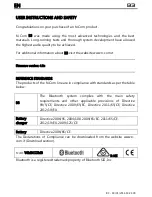
Group 1
Children who weigh between 9 kg and 18 kg
may be carried in a Group 1, forward facing
seat like the one in fig. B. This type of child
restraint is for older children who are too big
for a Group 0 or 0+ child restraint.
Group 2
Children who weigh between 15 kg and 25 kg
and who are too big for the Group 1 child
restraint may use a Group 2 child restraint
system.
As shown in fig. C, the Group 2 child restraint
system positions the child correctly with re-
spect to the seat belt so that the shoulder belt
crosses the child’s chest and not the neck,
and the lap belt is snug on the pelvis and not
the abdomen.
Group 3
Children who weigh between 22 kg and 36 kg
and who are tall enough to use the adult
shoulder belt may use a Group 3 child re-
straint. Group 3 child restraints position the
lap belt on the child’s pelvis. The child must
be tall enough that the shoulder belt crosses
the child’s chest and not their neck.
Fig. D shows an example of a Group 3 child
restraint system correctly positioning the
child on the rear seat.
Fig. B
Fig. C
Fig. D
SAFETY
112
Summary of Contents for WRANGLER 2017
Page 1: ...2017 WRANGLER USER GUIDE...
Page 6: ...4...
Page 7: ...GRAPHICAL TABLE OF CONTENTS INSTRUMENT PANEL 6 INTERIOR 7 GRAPHICAL TABLE OF CONTENTS 5...
Page 10: ...8...
Page 47: ...Operating Tips Chart 45...
Page 78: ...76...
Page 128: ...126...
Page 171: ...German Translation 169...
Page 220: ...218...
Page 260: ...258...
Page 276: ...CUSTOMER ASSISTANCE 274...
Page 277: ...275...
Page 278: ...276...
Page 286: ...284...
Page 287: ...285...
Page 288: ...286...
Page 289: ...287...
Page 290: ...288...
Page 291: ......
















































